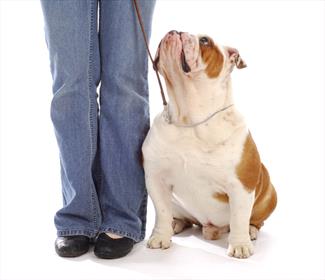Sit. Stay. Listen. Training the Owner to Train the Pet
Bulldog sitting at attention

Photo courtesy of Depositphotos
When I was a child, my dentist had a sign in his office. It said something like, “I cannot undo in 30 minutes what you have not done for 6 months.” Good point. Said differently and more broadly, the expert cannot care for your situation more than you care for your situation. What am I getting at here? I'm talking about behavior issues in pets.
While no one has been thrilled by the pandemic, it has allowed for some real-life experimentation to take place that otherwise wouldn't have happened. We now know that some employees really can work from home without losing all ability to be productive. We know that school is important for more than just learning. And we know that everything can be politicized. (Okay, maybe we all knew that before COVID.) One of the big experiments brought on by COVID for the veterinary community has been curbside practice, where the animal goes into the clinic while the owner waits outside, in a car, or some other nearby location.
Like many things in life, curbside has been a blessing and a curse. Some behavior issues have actually improved for veterinarians by not having the owner in the room. In some cases, the owner's anxiety about being there only fed into their pet's anxiety. Without the owner, some pets have been calmer and easier to work with. Occasionally, a video documenting the peaceful interaction between dog and doc has been utilized as evidence for the owner to see the improvement. For these owners, even when the practice has returned to having clients in the clinic, they may choose to wait in the car because the pet does better without them.
In other instances, the animal is untrained, ill-mannered, and perhaps even dangerous, and the clients are fighting the situation tooth and nail. The COVID-procured puppy is now a large, untrained adult. Owners were advised to institute training but it didn't happen. Staff members have been injured by these unruly beasts. Don't get me wrong: this was also happening BC (before COVID). It just seems worse than ever.
Neither veterinarians nor their staff members are able to teach a pet to behave appropriately if the owner is unwilling to put in the work. To be fair, training a puppy during COVID-19 has been harder. The lack of formal classes and social opportunities has made it more difficult, but not impossible (see a few resources below). That said, a dog that cannot walk on a leash from the car to the clinic without dragging the staff member or vice versa, won't magically return able to heel on command. If a cat has never been trained to accept nail trims at home without a spot-on impression of the Tasmanian devil, the veterinary team will not be able to instantly calm it into being a cooperative partner for a mani/pedi. Appropriate behavior is taught over time, in stages, with regular effort and gentle correction. (Really, it's no different than teaching children how to behave appropriately in public, but maybe therein lies the problem. And I will now step away from that can of worms.)
So, please, I'm begging you. Teach your dog standard manners like walking on a leash or lying down. Acclimate pets to normal procedures that you might do at home like trimming nails, cleaning ears, or giving medications. Not all cats are deathly afraid of their carriers if they've been desensitized to them at home. The more cooperative your pet is for an examination and care, the better off everyone will be. You could even save money because cooperative pets don't need sedation for basic procedures like blood draws and urine collection. If you train your pets, your reward will be a grateful and fulfilling partnership with your pet's medical team.
A few resources:
Dr. Sophia Yin, veterinary behaviorist
Body Language of Dogs
Leash Reactivity in Dogs
Fear and Fear-related Aggression in Dogs
Body Language of Cats
Getting your Cat into a Carrier
Cats and High Places: Keeping them off Counters and Tables